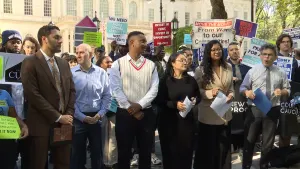More Stories
As kids
across Connecticut head back to school, new state data shows
student performance is still lagging behind pre-pandemic levels. But school
leaders see promising signs as classes return with no
masks and
relaxed COVID protocols.
"Make no mistake, we
still have a lot of work to do,” said state Education Commissioner Charlene
Russell-Tucker.
On Thursday, the Connecticut State Department of Education released a new Performance Index with data from the 2021-22 school year. It
shows language
arts proficiency dropped 3.5% from pre-pandemic levels, 4.5% for math, and 2.3% for
science.
"The effects of COVID-19 are serious, and we're still feeling the
ramifications of those,” said Joseph Macary, the school superintendent in Vernon.
CSDE estimates
students in grades 4-5 may be up to three months behind. Middle school
students could be more than a year behind in math.
Although
inner-city students scored lower overall, all school systems saw Performance
Index similar drops.
In western Connecticut, urban school systems dropped an
average of 4% for all three subjects:
- Bridgeport: -3.9%
- Norwalk: -3.9%
- Stamford: -4.4%
- Stratford: -3.8%
But even in a wealthy suburban districts,
students saw similar drops:
- New Canaan: -2.9%
- Greenwich: -1.3%
- Westport: -3.4%
However, there is some promising
news. The
state’s Pandemic Recovery Portal shows students are learning faster, especially kids in elementary school.
“Put simply, the faster the pace of learning, the
faster the recovery,” said Ajit Gopalakrishnan, CSDE’s chief performance officer.
Schools have come up with innovative ways to get students back on track.
"We built out a position in every school
that was specifically designed as a certified staff to work with students who
may be, for the past two years, have been home, working off a computer,” said East Hartford Schools Superintendent
Nathan Quesnel.
Charter schools stepped up too.
"We hired additional online teachers when we
were remote -- teachers who had taught at our school before, but were retired,”
said Ellen Retelle, the director of Integrated Day Charter Schools in Norwich.
“We hired tutors for two years for every single grade level."
But much of that innovation is dependent on
federal relief funding, which will run out in the coming years.
Plus, schools have a new challenge: a severe teacher
shortage.
“About 400-plus shortages that were reported to us, and also about 570-plus para-professional vacancies,” said Russell-Tucker.
“About 400-plus shortages that were reported to us, and also about 570-plus para-professional vacancies,” said Russell-Tucker.
Schools are getting creative about hiring too.
"We have the reciprocity policy that we
implemented, so we could attract educators from 11 other states and streamline
the process for them to be certified here,” said Russell-Tucker.
More from News 12
2:34

Guide: Safety tips to help prevent home burglaries
2:19

Guide: Safety measures to help prevent fires and how to escape one
2:40

Mayor's budget cuts: A controversial solution amidst immigration crisis
2:07

Tips on how to avoid confrontation with sharks while swimming in the ocean
2:33

5 tips to prevent mosquito bites and getting sick from viruses
2:39
